When designing Tasha’s Cauldron of Everything, the game designers at Wizards of the Coast tapped veteran RPG puzzle designer Elisa Teague to create nearly an entire chapter's worth of puzzles for your D&D game. Her work includes the masterful Alternate Reality Game that preceded D&D Live 2018: Stream of Many Eyes, known commonly as the “Leave No Stone Unturned” puzzle. Let’s expand on her masterful work and create simple, useful rules for designing puzzles for your dungeons!
What is a Puzzle?
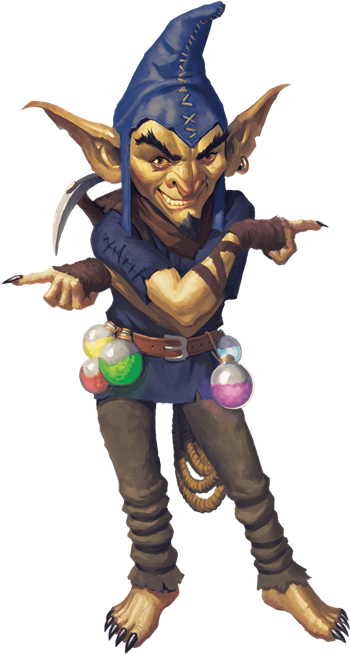 Of course, we all know instinctually what a puzzle is. It’s a test of cognitive skill to solve a challenging, often abstract task. There are dozens of different types of puzzles, and designing your puzzle around a classic archetype can make it easier to create a puzzle than starting from scratch every time. The trouble is, with so many different types of puzzles, how can you know what types are fun to untangle in D&D, and which will leave you bored?
Of course, we all know instinctually what a puzzle is. It’s a test of cognitive skill to solve a challenging, often abstract task. There are dozens of different types of puzzles, and designing your puzzle around a classic archetype can make it easier to create a puzzle than starting from scratch every time. The trouble is, with so many different types of puzzles, how can you know what types are fun to untangle in D&D, and which will leave you bored?
There’s no one-size-fits-all solution; every D&D group is made up of players with different tastes and preferences, so something that wins your Friday group over may fall flat with your Sunday group, and vice versa. And that’s to say nothing about your own preferences as a Dungeon Master! Don’t forget that you should be having fun in-game, too.
- Word Puzzles. Like the Reckless Steps puzzle in Tasha’s Cauldron of Everything, word puzzles rely on the players to identify words or letters, like an in-universe crossword puzzle.
- An oral cousin to the more visual word puzzle, a good riddle (like the Eye of the Beholder puzzle) gets you to think about hidden meanings in phrases.
- Number Puzzles. Some classic puzzles require you to arrange numbers in a specific order, like a Sudoku puzzle. Exact Change is a good example of this type of puzzle. Additionally, a number of puzzles in Tasha’s Cauldron of Everything also use numbers and words together, requiring you to think about the relationship between letters and numbers. Members Only is a good example of this type of combination puzzle.
- Logic Puzzles. These puzzles, like the medium puzzle Four-By-Four test inductive reasoning and relationships between puzzle elements. They are often solved using a logic matrix.
In-Character Knowledge versus Out-of-Character Reasoning
When solving a puzzle, should players use what they know from the real world, or can they only use the knowledge that their characters have? Likewise, should they use their own intelligence, or should they try to play to their character’s level of intelligence? How do you pretend to not know things if you’re playing an uneducated mercenary with only 8 Intelligence—or worse, how do you magically become smarter than you are if you’re playing a sage with 19 Intelligence, a genius-level intellect?
This vexing problem becomes worse if the Dungeon Master and the players are in disagreement about what the right way to handle a puzzle is. Disaster ensues if the DM wants the players to solve the puzzle in-character while the players want to use any means at their disposal to emerge victorious.
There’s no right answer to this problem—every table is different, after all—but the most one-size-fits-all solution is to just let the players use real-world knowledge and their own intellect to solve the puzzle. Don’t ask them to dumb themselves down to the level of their characters. And if a player isn’t as smart as their genius-level wizard, have some hints on hand that use the characters’ ability scores and skill or tool proficiencies to find information that they might not have otherwise thought of out-of-character.
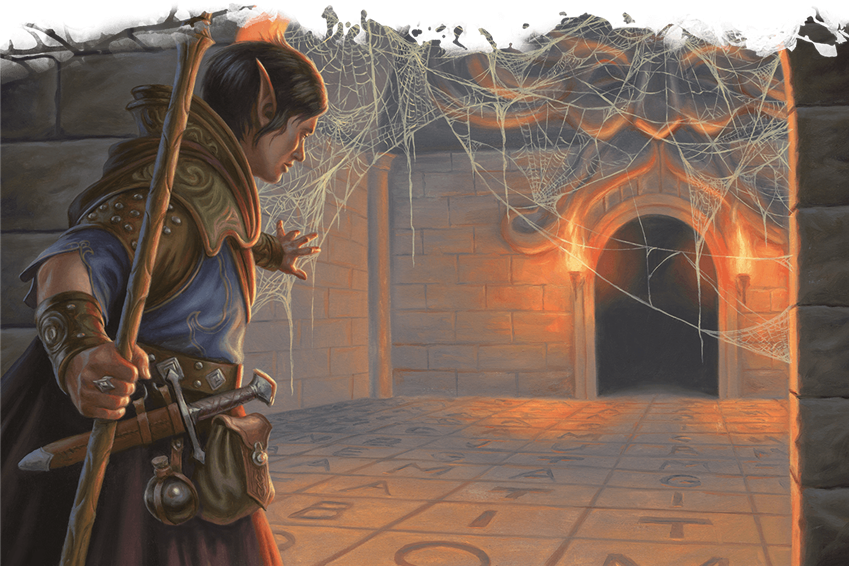
A Puzzle’s Story
Being a Dungeon Master means learning a little bit of game design to make sure that your game is specially tailored for your players. Soup from a can tastes fine, but imagine the difference between canned chicken soup and a hearty, homemade soup made from bones you’ve stewed for hours. If you want to make gourmet puzzles for your D&D group, you have to understand that the mark of a good puzzle isn’t necessarily that it confounds the players—it’s that it creates a satisfying story. D&D is a group activity played with friends, and often keeping the game moving is more important than providing a devilish challenge. The secret to making a good puzzle is landing the bullseye in the dead center of flow and difficulty.
That bullseye is a puzzle with a story arc with rising action and challenges, just like you might see in a Storytelling 101 class. If the puzzle was well-designed and well-suited to the players’ skill, they will feel like they’ve gone on a narrative journey when they solve it, rather than simply overcoming a speed bump. Here’s a three-step process to making a narratively satisfying puzzle.
The Question and the Statement
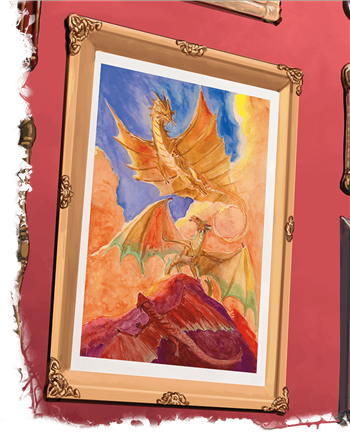 The puzzle begins by making a statement and posing a question. This could be a literal statement of terms, such as a bronze plaque which states: “To progress past this room, you must speak aloud the names of the Five Great Kings of Oa.” The room is filled with a dozen portraits of people, each with their name inscribed on the frame. In this situation the question is implicit; the room asks “which of these dozen people are the Five Great Kings of Oa?” The characters must figure out that these portraits have traits that a legendary monarch would have, such as a crown, a scepter, a signet ring bearing a royal crest, and so forth.
The puzzle begins by making a statement and posing a question. This could be a literal statement of terms, such as a bronze plaque which states: “To progress past this room, you must speak aloud the names of the Five Great Kings of Oa.” The room is filled with a dozen portraits of people, each with their name inscribed on the frame. In this situation the question is implicit; the room asks “which of these dozen people are the Five Great Kings of Oa?” The characters must figure out that these portraits have traits that a legendary monarch would have, such as a crown, a scepter, a signet ring bearing a royal crest, and so forth.
The statement doesn’t have to be so explicit, however. Consider how the puzzle changes if the characters entered this same room and you described the portraits, and then a locked door with the ancient royal crest of Oa upon it inscribed upon it five times in a pentagon. In this trickier scenario, the puzzle also requires the characters to:
- Realize that there’s a puzzle at all
- Infer the terms of the puzzle by their surroundings
Generally, it’s easier to give a puzzle an explicit statement and an implicit question. However, if you make your question explicit (perhaps a plaque upon the door which reads, “Only those who possess knowledge of history long-lost is worthy to pass me”), then you can still get the characters to infer the terms of the puzzle through their surroundings without requiring them to first realize that they’ve stepped into a puzzle.
The Wall and the Perspective Shift
All a puzzle really needs to be great is a statement and a question. That’s essentially just a riddle you’ve introduced some multimedia elements into. However, to make a puzzle truly exceptional requires you to borrow from the magician’s playbook. Anyone who’s seen The Prestige (the 2006 film by Christopher Nolan) knows that there are three stages to a real-life magic trick: the pledge, the turn, and the prestige. In many ways, this applies to a good puzzle, because the goal of the illusionist and the puzzle master are the same: tell a compelling story. The main difference is that the illusionist wants to conceal the inner workings of their magic, whereas the puzzle master wants the audience to understand the puzzle inside and out to discover the solution.
In this magician’s schema, “the turn” is when something that’s ordinary is revealed to be extraordinary. The audience’s expectations are turned on their head—it shifts their perspective. In a puzzle, the perspective shift occurs when the puzzlers hit a wall. Their premises were flawed; something they thought was certain about the puzzle—typically the statement—is wrong. It’s not an outright lie, that would be a dirty trick, but the statement was phrased in such a way to play upon your assumptions. This wall will stand impenetrably tall unless the puzzlers stop for a moment, step back, reconsider what they took for granted to be true, perhaps incorporate new information they learned elsewhere, and see the puzzle with fresh eyes.
Since this section of the puzzle is often where players get stuck, it’s important to have a few hints prepared (as discussed in the “Puzzle Elements” section of Tasha’s Cauldron of Everything). Having hints that the characters can make checks to discover helps strike a balance between not just player knowledge vs. character knowledge, but also between challenge and game flow.
One good way to do this is to tie the puzzle into the larger scheme of the campaign, or the even just the dungeon the puzzle is found in. In our portrait example, let’s say that the dungeon so far has been themed around dragons—the five colors of chromatic dragons, specifically. Statues litter the dungeon depicting ancient kings (with long-eroded faces), and each one of these kings has a differently colored chromatic dragon at his side. No such dragons appear in the portraits, but astute characters will realize that even though many of the people in portraits appear to be noble, even regal, only one portrait each shows someone dressed in black, blue, green, red, and white. These kings are not all dressed in regal finery, but instead wear the color of their bonded dragon.
The Epiphany
 The perspective shift is the key to unlocking the entire puzzle. Once the characters have changed their perspective, the rest of the puzzle should rapidly fall into place, causing the wall that blocked them to crumble away until the solution is clear. This is a series of rapid-fire epiphanies as the puzzlers apply their newfound perspective to individual puzzle elements in turn. The key to this epiphany is rooted in the beginning of your puzzle; it has to be rooted in clear, simple concepts, not cheap tricks. Indie puzzle game designer Jonathan Blow (Braid, The Witness) told Gamasutra in 2014, "...the more that a puzzle is about something real and something specific, and the less it's about some arbitrary challenge, the more meaningful that epiphany is."
The perspective shift is the key to unlocking the entire puzzle. Once the characters have changed their perspective, the rest of the puzzle should rapidly fall into place, causing the wall that blocked them to crumble away until the solution is clear. This is a series of rapid-fire epiphanies as the puzzlers apply their newfound perspective to individual puzzle elements in turn. The key to this epiphany is rooted in the beginning of your puzzle; it has to be rooted in clear, simple concepts, not cheap tricks. Indie puzzle game designer Jonathan Blow (Braid, The Witness) told Gamasutra in 2014, "...the more that a puzzle is about something real and something specific, and the less it's about some arbitrary challenge, the more meaningful that epiphany is."
In our example, once a character realizes that each of the Five Great Oan Kings was bonded to a chromatic dragon, the realizations that each of the kings bears the color of their dragons should come fast and furious. “This one’s the only one wearing red! This one’s the only one in white…” until the puzzlers find the solution and open the door.
It’s possible that, if the players are particularly canny, their perspective will be properly aligned right from the start. So there will never be an epiphany, just a rather limp discovery that their first guess was right all along. It’s always disappointing when this happens, but don’t despair. Take that as an indication that you can ratchet up the difficulty of your next puzzle to really get your players thinking.
Have you ever included puzzles in your D&D campaigns? What was one that your players will never forget? Let us know in the comments!
Create A Brand-New Adventurer Acquire New Powers and Adventures Browse All Your D&D Content
 James Haeck is the lead writer for D&D Beyond, the co-author of Waterdeep: Dragon Heist, Baldur's Gate: Descent into Avernus, and the Critical Role Explorer's Guide to Wildemount, a member of the Guild Adepts, and a freelance writer for Wizards of the Coast, the D&D Adventurers League, and other RPG companies. He lives in Seattle, Washington with his fiancée Hannah and their animal companions Mei and Marzipan. You can find him wasting time on Twitter at @jamesjhaeck.
James Haeck is the lead writer for D&D Beyond, the co-author of Waterdeep: Dragon Heist, Baldur's Gate: Descent into Avernus, and the Critical Role Explorer's Guide to Wildemount, a member of the Guild Adepts, and a freelance writer for Wizards of the Coast, the D&D Adventurers League, and other RPG companies. He lives in Seattle, Washington with his fiancée Hannah and their animal companions Mei and Marzipan. You can find him wasting time on Twitter at @jamesjhaeck.








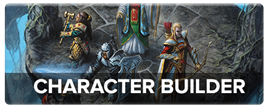
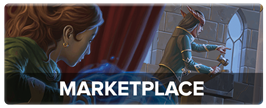
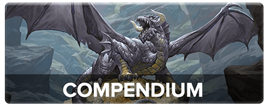
-
View User Profile
-
Send Message
Posted Nov 25, 2020My greatest challenge in creating a puzzle is balancing the difficulty of it.
-
View User Profile
-
Send Message
Posted Nov 25, 2020cool article! I can never make good puzzles!
-
View User Profile
-
Send Message
Posted Nov 25, 2020I've done a few puzzles while DM'ing. One trick I found was to include some puzzle elements in combat (Such as having enemies interact and change the terrain, implicitly giving players the same options.)
As for pure puzzles, a classic is the mirror room. The puzzle is as follows: The room has two doors, the one the players entered from, and another (fake) door on the far wall. An invisible barrier splits the room in half, preventing access to the fake door. The real door is hidden behind an illusion of a wall opposite the fake door. The invisible barrier is just a mirror enchanted to not show living things (or anything they are wearing/carrying).
-
View User Profile
-
Send Message
Posted Nov 25, 2020One thing: Why would the creators of a dungeon want to add puzzles (assuming the dungeon isn’t a test or trial)?
-
View User Profile
-
Send Message
Posted Nov 25, 2020That's a good question! A puzzle may be part of a test or trial like you suggested, but it could also say something about the character of whoever created a dungeon. An overconfident lich who wants more to be entertained by adventurers entering their dungeon might set up puzzles to amuse themself. Alternatively, a puzzle may be an elaborate password. The Member's Only puzzle in Tasha's is of that nature.
-
View User Profile
-
Send Message
Posted Nov 25, 2020If you’re a nigh immortal being that has the power and potential like some of the beings that make dungeons in Like Forgotten Realms and Greyhawk the best reason for a lot of them would be “because I can” and most normal people eventually become meaningless to the immortal as they get older so only the other immortals tend to be regarded as worth anything.
-
View User Profile
-
Send Message
Posted Nov 25, 2020As an escape room owner and all-things-puzzle aficionado, never ever forget the "Prestige" part of a puzzle. Yes, part of the thrill of solving puzzles is finding the solution in a clever way (an "epiphany" like James said in the article), but keep in mind that as DMs part of our role is to narrate how the world reacts to our players' actions - use that feedback to surprise your players. It's ok if the players found the "Five Great Oan Kings" to open the door, but opening doors is something mundane - even if they're locked in a clever way. But if the players solve the puzzle and the puzzle reacts to the solution in an unexpected way (for example, opening a secret passage behind one of the pictures instead of unlocking the door) your players will feel more engaged in the world you're both creating and the thrill will be doubled: by finding the solution and by its reward.
-
View User Profile
-
Send Message
Posted Nov 25, 2020You can't. You can only create individual threads.
-
View User Profile
-
Send Message
Posted Nov 25, 2020Do you mean threads (things where the only things present are the title, possibly votes, and comments) or articles (like this one)?
-
View User Profile
-
Send Message
Posted Nov 25, 2020Go to the forum you want to make it on, then click New Thread.
-
View User Profile
-
Send Message
Posted Nov 25, 2020Those are definitely some examples. However, a puzzle might not be something designed for the party to crack or something that the puzzle creators regularly use. For example, let's say that there is a wall blocking the way into a chamber, and the wall is covered in runes. The creator uses the runes to make the wall magically move out of the way by pressing the runes in the right order, but the party doesn't know the order. The creator has left hints in case they forget it or want someone else to find out the information by telling them where to look. With enough investigating, the party could find the hints and piece them together, thus turning something meant to be impassable or something that was meant to only be known to certain people can be cracked by the party using their brains and some Investigation rolls.
-
View User Profile
-
Send Message
Posted Nov 25, 2020Well said!
-
View User Profile
-
Send Message
Posted Nov 26, 2020The problem with the puzzles in Tasha's is they nearly all relay on the Modern English language - spelling, shapes of letters, etc. This can be immersion breaking if (like Tolkien) you consider the language spoken in your world to be something other than Modern English. Or your world to have pseudo-medieval technology - spellings where not standardised until the 17th century.
-
View User Profile
-
Send Message
Posted Nov 26, 2020This is so useful! Thank you! I have definitely found that some groups like some types of puzzles more than others. Love this article, I am going to use it a LOT.
-
View User Profile
-
Send Message
Posted Nov 26, 2020This has been very helpful. I love puzzles, but can never deliver them properly.
-
View User Profile
-
Send Message
Posted Nov 26, 2020Never made a puzzle, but this is a good idea!